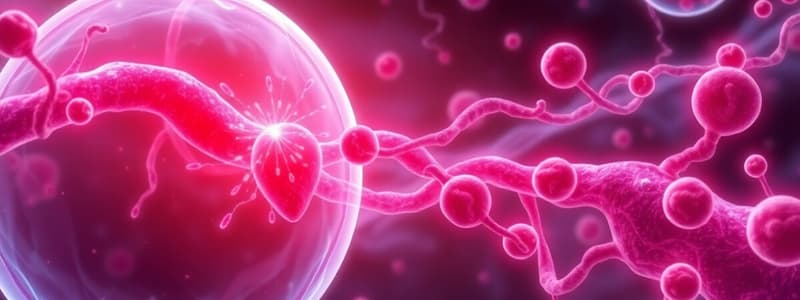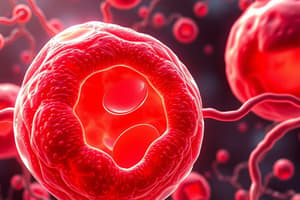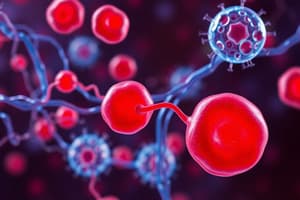Podcast
Questions and Answers
What are the first blood cells formed during the mesoblastic phase of hematopoiesis?
What are the first blood cells formed during the mesoblastic phase of hematopoiesis?
- Eosinophilic stem cells
- Pluripotential stem cells
- Fetal erythroblasts
- Primitive erythroblasts (correct)
Which statement best describes the polyphyletic theory of hematopoiesis?
Which statement best describes the polyphyletic theory of hematopoiesis?
- Each blood lineage comes from a unique stem cell. (correct)
- The theory is based on the function of the fetal liver.
- All blood cells are derived from a single progenitor stem cell.
- Blood cells can arise from both yolk sac and bone marrow simultaneously.
During which phase of hematopoiesis is fetal hemoglobin (Hb F) predominantly produced?
During which phase of hematopoiesis is fetal hemoglobin (Hb F) predominantly produced?
- Intramedullary phase
- Postnatal phase
- Hepatic phase (correct)
- Mesoblastic phase
At what point in development does hematopoiesis start in the bone marrow cavity?
At what point in development does hematopoiesis start in the bone marrow cavity?
Which of the following is a classical marker for hematopoietic stem cells?
Which of the following is a classical marker for hematopoietic stem cells?
Which organ is considered the first fully developed organ in the fetus and a major site of T cell production?
Which organ is considered the first fully developed organ in the fetus and a major site of T cell production?
Which type of hematopoiesis occurs intravascularly within developing blood vessels?
Which type of hematopoiesis occurs intravascularly within developing blood vessels?
What is the primary function of primitive erythroblasts during early embryogenesis?
What is the primary function of primitive erythroblasts during early embryogenesis?
Which of the following locations are primary sites for hematopoiesis in adults?
Which of the following locations are primary sites for hematopoiesis in adults?
At what age does the process of retrogression in bone marrow typically occur?
At what age does the process of retrogression in bone marrow typically occur?
What type of marrow is characterized as hematopoietically inactive and contains adipocytes?
What type of marrow is characterized as hematopoietically inactive and contains adipocytes?
Which organs are considered primary lymphoid organs where T and B lymphocytes originate?
Which organs are considered primary lymphoid organs where T and B lymphocytes originate?
In adults, what proportion of bone marrow is red versus yellow?
In adults, what proportion of bone marrow is red versus yellow?
What is a major function of secondary lymphoid organs like the spleen and lymph nodes?
What is a major function of secondary lymphoid organs like the spleen and lymph nodes?
Which statement accurately reflects the role of yellow marrow during increased physiological demand?
Which statement accurately reflects the role of yellow marrow during increased physiological demand?
Which phase of hematopoiesis is characterized by the transition from mesoblastic to hepatic production of blood cells?
Which phase of hematopoiesis is characterized by the transition from mesoblastic to hepatic production of blood cells?
In adults, which type of bone marrow primarily contributes to hematopoiesis?
In adults, which type of bone marrow primarily contributes to hematopoiesis?
At what developmental stage do T and B lymphocytes begin to differentiate in primary lymphoid organs?
At what developmental stage do T and B lymphocytes begin to differentiate in primary lymphoid organs?
Which statement accurately describes the role of stem cells during hematopoiesis?
Which statement accurately describes the role of stem cells during hematopoiesis?
Which organ plays a crucial role in the immune response by facilitating the maturation of lymphocytes?
Which organ plays a crucial role in the immune response by facilitating the maturation of lymphocytes?
What is the primary advantage of a bone marrow biopsy compared to a bone marrow aspirate?
What is the primary advantage of a bone marrow biopsy compared to a bone marrow aspirate?
What does a myeloid-to-erythroid (M:E) ratio of 10:1 typically indicate?
What does a myeloid-to-erythroid (M:E) ratio of 10:1 typically indicate?
In which condition is extramedullary hematopoiesis most likely to occur?
In which condition is extramedullary hematopoiesis most likely to occur?
What constitutes the erythron within the context of erythropoiesis?
What constitutes the erythron within the context of erythropoiesis?
How long should bone marrow smears be retained for examination?
How long should bone marrow smears be retained for examination?
Flashcards
Hematopoiesis
Hematopoiesis
The process of blood cell formation
CD 34
CD 34
A classical marker of hematopoietic stem cells
Polyphyletic Theory
Polyphyletic Theory
Each blood cell lineage comes from a separate stem cell
Monophyletic Theory
Monophyletic Theory
Signup and view all the flashcards
Mesoblastic/Megaloblastic Hematopoiesis
Mesoblastic/Megaloblastic Hematopoiesis
Signup and view all the flashcards
Hepatic Hematopoiesis
Hepatic Hematopoiesis
Signup and view all the flashcards
Intramedullary/Medullary/Myeloid Hematopoiesis
Intramedullary/Medullary/Myeloid Hematopoiesis
Signup and view all the flashcards
Adult Hematopoiesis Location
Adult Hematopoiesis Location
Signup and view all the flashcards
Bone Marrow Function
Bone Marrow Function
Signup and view all the flashcards
Retrograde Hematopoiesis
Retrograde Hematopoiesis
Signup and view all the flashcards
Red Marrow
Red Marrow
Signup and view all the flashcards
Yellow Marrow
Yellow Marrow
Signup and view all the flashcards
Primary Lymphoid Organs
Primary Lymphoid Organs
Signup and view all the flashcards
Secondary Lymphoid Organs
Secondary Lymphoid Organs
Signup and view all the flashcards
Hematopoiesis
Hematopoiesis
Signup and view all the flashcards
Bone Marrow
Bone Marrow
Signup and view all the flashcards
Red Marrow
Red Marrow
Signup and view all the flashcards
Yellow Marrow
Yellow Marrow
Signup and view all the flashcards
Primary Lymphoid Organs
Primary Lymphoid Organs
Signup and view all the flashcards
Secondary Lymphoid Organs
Secondary Lymphoid Organs
Signup and view all the flashcards
Marrow Differential
Marrow Differential
Signup and view all the flashcards
Bone Marrow Aspiration
Bone Marrow Aspiration
Signup and view all the flashcards
Bone Marrow Biopsy
Bone Marrow Biopsy
Signup and view all the flashcards
M:E Ratio
M:E Ratio
Signup and view all the flashcards
Extramedullary Hematopoiesis
Extramedullary Hematopoiesis
Signup and view all the flashcards
Erythropoiesis
Erythropoiesis
Signup and view all the flashcards
Study Notes
Sample Question
- A laboratory student consistently makes wedge-technique blood films that are too long and thin
- Correcting the issue would include moving the drop of blood closer to the center of the slide
- Increasing the acute angle of the pusher slide
Hematopoiesis
- Hematopoiesis is the process of blood cell formation
- CD34 is a classical marker for hematopoietic stem cells
- Hematopoiesis begins around the 19th day of embryonic development after fertilization
Two Related Theories
- Polyphyletic Theory: Suggests each blood cell lineage originates from a unique stem cell
- Monophyletic Theory: Suggests all blood cells originate from a single pluripotential stem cell (PSC)
- The most widely accepted theory amongst hematologists is the monophyletic theory
Three Phases of Hematopoiesis
-
Mesoblastic/Megaloblastic:
- Chief site: Yolk Sac
- First blood cells: Primitive Erythroblasts (PE) produced during the first 2 to 8 weeks of life
- PE are important in early embryo-genesis to produce hemoglobin (Gower-1, Gower-2, and Portland) which is essential for the delivery of oxygen to embryonic tissues
- Yolk sac hematopoiesis occurs intravascularly (within developing blood vessels) which differs from later hematopoiesis occurring in the fetal and adult stages.
-
Hepatic:
- Chief site: Fetal Liver
- Hemoglobin: Hb F (Fetal hemoglobin) is dominant during the phase
- Organs: Thymus (first fully developed organ in the fetus, increases in size during fetal development, major site of T cell production), Kidneys and Spleen (produce B cells)
-
Intramedullary/Medullary/Myeloid:
- Chief site: Red Bone Marrow
- Hematopoiesis starts in the bone marrow cavity before the 5th month of fetal development.
- Bone marrow becomes the chief site by the end of 24 weeks' gestation
Studying That Suits You
Use AI to generate personalized quizzes and flashcards to suit your learning preferences.




